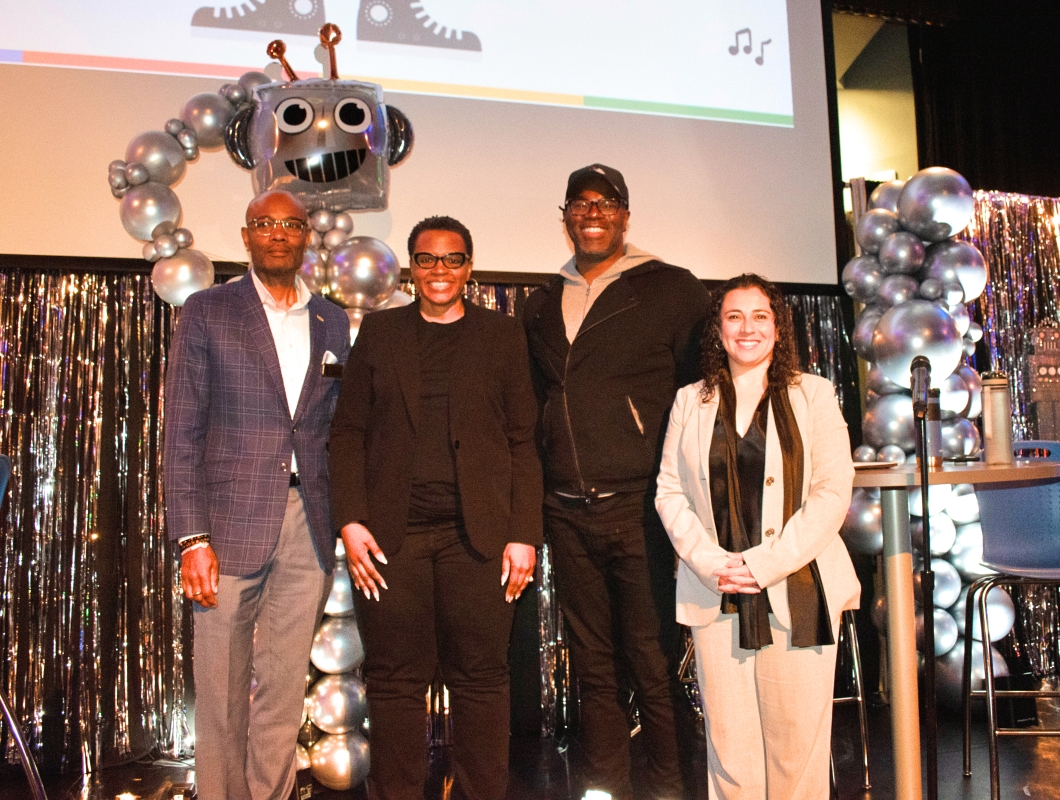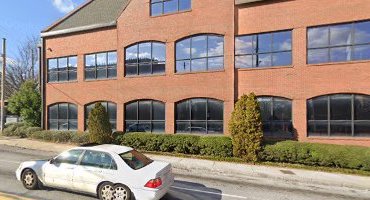December 8, 2023
Almost 100 Benjamin E. Mays High School students are currently working on yearlong capstone projects that combine computer science, robotics, and other STEM disciplines in its newly installed technology hub thanks to a collaborative partnership between Georgia Tech’s Center for Education Integrating Science, Mathematics, and Computing (CEISMC) and Google. During the project, the objective is to train the entire high school faculty on the use and implementation of the tech hub so that it can be a resource for the full student body.
 “The overarching goal for this initiative is student-focused and student-driven. We want to provide unique experiential experiences in engineering, data center operations, cloud computing, machine learning, and supply chain, using Google technologies.” said Google’s Global Head of Modeling and Technical Innovation Nathaniel W. Tindall III. “Through these learning opportunities and interactions with Google employees who are already working in these roles, we can help the students discover new possibilities and opportunities for their future.”
“The overarching goal for this initiative is student-focused and student-driven. We want to provide unique experiential experiences in engineering, data center operations, cloud computing, machine learning, and supply chain, using Google technologies.” said Google’s Global Head of Modeling and Technical Innovation Nathaniel W. Tindall III. “Through these learning opportunities and interactions with Google employees who are already working in these roles, we can help the students discover new possibilities and opportunities for their future.”
“We are thrilled to partner with Google to open a tech hub at Benjamin Mays High School,” added Lizanne DeStefano, CEISMC’s executive director. “This is a wonderful opportunity for the students and their teachers to learn and grow together in STEM fields. We hope this will ignite their interest and passion in STEM and help them develop the skills and confidence they need to succeed in the 21st century.”
The tech hub, housed in a renovated classroom that is customized with a STEAM-inspired whimsical mural on one wall, is equipped with project materials such as robotic kits, microcontrollers, sensors, wiring, and motors. The room is also outfitted with alternative workspaces and flexible seating arrangements to support increased engagement, productivity, and motivation during the hands-on activities.
“We are super excited about this partnership and what it means for the students at Mays High School,” said Principal Ramon Garner. “The tech hub will not only enhance our learning environment, but also inspire our students to pursue their passions and dreams in the STEM fields.”
CURRICULUM DEVELOPMENT
Planning for the technology hub, and the creation of an accompanying integrated curriculum began this past spring when Tindall approached Norman “Storm” Robinson III, CEISMC’s Associate Director for School and Community Engagement. The two had previously worked together on other education-focused projects.
After meeting over several months with all stakeholders, Robinson and his CEISMC team developed three distinct capstone projects that illustrate the full potential of the hub’s capabilities while bringing real-world applications of tech-specific jobs to the students’ attention. All the projects are grounded in problem-based learning, a teaching approach that helps students apply their knowledge to authentic situations and to see the connections between different fields and concepts.
 “This initiative demonstrates how we need to transform our K-12 learning environments to be more adaptable, engaging, and relevant to the interests and aspirations of students,” said Robinson. “By doing so, we can prepare them for the future creative economies that require skills such as innovation, collaboration, and problem-solving. More importantly, these students are acquiring computational and computer science skills that will enable them to earn a livable wage.”
“This initiative demonstrates how we need to transform our K-12 learning environments to be more adaptable, engaging, and relevant to the interests and aspirations of students,” said Robinson. “By doing so, we can prepare them for the future creative economies that require skills such as innovation, collaboration, and problem-solving. More importantly, these students are acquiring computational and computer science skills that will enable them to earn a livable wage.”
To prepare for a fall launch, the CEISMC team hosted and facilitated professional development sessions for a group of Mays High School instructors over the summer. “We tailored the lessons to be carried out in everyday instruction in multiple disciplines so that all STEM educators at Mays can expand their content knowledge and competencies while utilizing the various educational technologies,” explained CEISMC Program Director Alba Castillo Gutierrez, who leads the operations, administration, and coordination of the curricular activities. “We also wanted to ensure that these experiences can provide the foundational knowledge required to help the educators design their own projects in the future using the tech hub resources.”
LaToya Morgan, Mays’ Assistant Principal for International Baccalaureate and Signature Programs, was also in attendance for some of the sessions and said that she gained valuable insight by participating in the hands-on activities.
“I think the professional development session was very valuable and informative for our teachers and me,” said Morgan. “Through the learner’s perspective, a main takeaway was how important it is to create a positive and resilient learning environment, where students are encouraged to take on challenges, learn from mistakes, and seek feedback.”
PROJECT IMPLEMENTATION
 The current projects that are being carried out during this pilot year involve constructing a gaming network server, building a robot that will serve as a school tour guide and creating microcontroller applications based on student inquiry of a community issue.
The current projects that are being carried out during this pilot year involve constructing a gaming network server, building a robot that will serve as a school tour guide and creating microcontroller applications based on student inquiry of a community issue.
Information technology instructor Anbria Powell is leading the gaming network server project with her group of mostly 12th graders. Part of the project includes building and programming a robotic arm that will install/uninstall device drivers or handle maintenance issues such as heat to increase the efficiency of the server.
Powell said that this project not only reinforces key concepts of networking maintenance that plays an intricate role in the gaming experience, but also brings a relatable experience to her students, serving as a bridge to engage them in discussions about STEM subjects and careers.
“The most memorable moment thus far working in this partnership is having employees from Google and Georgia Tech spend their time to enhance the knowledge of my students who are exploring innovative ideas and strategies while approaching this project,” Powell explained. “The real-world experience of building a robotic arm has given them an opportunity to reflect and understand their strengths and weaknesses in the development of the gaming network server.”
Engineering technology instructor Mariama Boone is working on the “Raider Tourbot” capstone project with her students, who are a mixture of 11th-12th graders. The students are applying the engineering design process to build, design, and program an autonomous robot that will use radio-frequency identification (RFID) and other sensors to guide visitors around the school and show them noteworthy points of interests and historic milestones.
 “As a high school engineering teacher, it feels like every year the STEM industry employability demands and K-12 career awareness opportunities are diverging farther apart,” said Boone. “Yet the Google, Benjamin Mays High School, and CEISMC partnership on the school-based technology hub is helping to bridge this gap.”
“As a high school engineering teacher, it feels like every year the STEM industry employability demands and K-12 career awareness opportunities are diverging farther apart,” said Boone. “Yet the Google, Benjamin Mays High School, and CEISMC partnership on the school-based technology hub is helping to bridge this gap.”
In preparation for the tech hub partnership, Boone also brought 45 of her engineering students to Georgia Tech in late September. She said that they met President Ángel Cabrera when they first arrived at the John Lewis Student Center, who took a few minutes to talk with them before they went on to a recruitment and admissions presentation with Tech’s Office of Minority Educational Development (OMED).
The third capstone project, led by mathematics instructor Leah Leonard, involves 11th graders in her computer science principles class using microcontrollers for innovative change. In this instance, Leonard explained that the students will create solutions in response to the challenges and goals set forth in the United Nations’ Sustainable Development Goals, relating these goals to their communities specifically.
“I believe opportunities such as this enhance the overall learning experiences of a child,” Leonard said. “Only knowledge that is used sticks in the mind. With this partnership, students have a chance to apply what is learned in a real-world context, and in my classes, I believe that my students can enhance their mathematical reasoning, critical thinking, and creativity, by demonstrating the coding and software development principles through this experience in the tech hub.”
Leonard also cites the interactions with the Google and CEISMC teams as an important outcome of this partnership for her students. She said they can better understand the idea that learning occurs everywhere and that the knowledge and experience attained can be used to improve one’s community.
MENTORS AND VOLUNTEERS
 The tech hub initiative also includes college peer mentors who are pursuing degrees in computer science and other related fields. Students from Spelman College, Morehouse College, and Georgia Tech are sharing their expertise and experiences directly with the high schoolers during the assigned “Tech Hub Phase Days” in which CEISMC and Google volunteers visit to help move the capstone projects along. In between visits, the CEISMC team provides additional curricular expertise and assistance to ensure the projects are running smoothly.
The tech hub initiative also includes college peer mentors who are pursuing degrees in computer science and other related fields. Students from Spelman College, Morehouse College, and Georgia Tech are sharing their expertise and experiences directly with the high schoolers during the assigned “Tech Hub Phase Days” in which CEISMC and Google volunteers visit to help move the capstone projects along. In between visits, the CEISMC team provides additional curricular expertise and assistance to ensure the projects are running smoothly.
“We are bringing in different partners so that the students can listen to various perspectives from people who represent different stages of the lifetime learning continuum,” explained Rian-Ashlei McDonald, who serves as Google’s project manager on this initiative. “Our partners show them the paths and possibilities that STEM education and careers can offer, inspiring them to pursue their own passions and goals, while communicating to them the viable career opportunities available, especially at Google.”
In fact, the technology hub initiative is part of a larger community partnership Google has formed with Mays High School to provide students with opportunities to explore STEM careers. Last fall, Google partnered with Big Brothers Big Sisters of Metro Atlanta (BBBSMA) in which Google employees serve as mentors to the students who visit them in the workplace through BBBSMA’s site-based mentoring program called Beyond School Walls.
“As a company, we have a responsibility to enable positive impact in the communities that we serve,” said Felica Coney, Google's Vice President of Global Data Center Server Operations. “We know the challenges in the community require investments of funding, investments of time and investments of effort. As a company, we are committed to being a part of the solution, supporting our community and providing opportunities for all.”
—Joëlle Walls, CEISMC Communications


